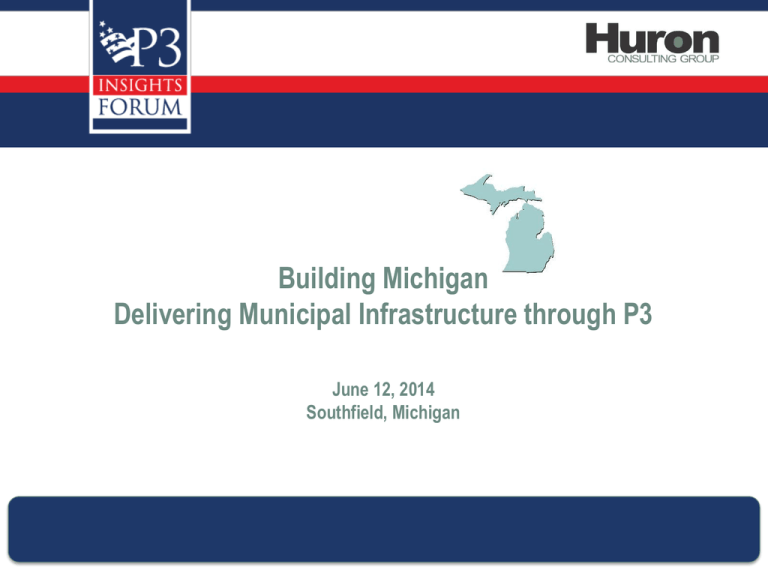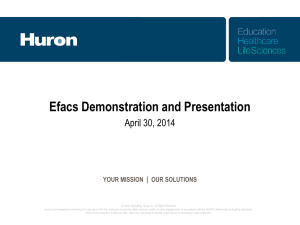
Building Michigan
Delivering Municipal Infrastructure through P3
June 12, 2014
Southfield, Michigan
Public-Private-Partnerships for Social Infrastructure
2
The Infrastructure Challenge
•
•
•
•
Global Infrastructure Deficit
Global infrastructure investment needs by 2030
estimated at $57-$67 Trillion (OECD / WEF)
US infrastructure needs estimated at over $7 Trillion
(by 2030), just to keep pace with GDP
It is expected that over 50% of these investments will
not be able to be funded by public authorities in a
timely manner (fiscal restraints, budget limitations,
debt ceilings, repayment capacity, etc.).
Standard & Poor’s estimates that the majority of
public infrastructure spending will go to energy and
transportation, putting other sectors at risk.
Michigan Investment Needs
• With a ASCE rating of “D”, Michigan has extensive
infrastructure investment needs in all sectors:
• $8.9 Billion for schools
• $15 Billion for water and wastewater systems
• Between $1.3-$2 Billion per year shortfall in
transportation infrastructure funding
• Unmet need of $272 million related to governmentfunded parks across the state
• Unknown investment to repair and expand other
infrastructure (buildings, dams, student housing, etc.)
© 2014 Huron Consulting Group. All Rights Reserved.
To bridge the funding gap, as
well as to ensure that
infrastructure and services are
delivered as efficiently and costeffectively as possible, public
authorities are turning to
alternative delivery and financing
methods, such as public-privatepartnerships (P3).
3
The P3 Promise
• There is no universal definition of P3, but generally speaking P3 refer to any of a
number of contracting arrangement involving risk-sharing, bundled services, and an
asset life-cycle focus.
• Contracts are differentiated by risk allocation and scope of services:
© 2014 Huron Consulting Group. All Rights Reserved.
4
The P3 Promise
© 2014 Huron Consulting Group. All Rights Reserved.
5
The P3 Promise
© 2014 Huron Consulting Group. All Rights Reserved.
6
The P3 Promise
• There is no universal definition of P3, but generally speaking P3 refer to any of a
number of contracting arrangement involving risk-sharing, bundled services, and an
asset life-cycle focus.
• Contracts are differentiated by risk allocation and scope of services:
• The decision as to which delivery and finance structure should be utilized for each
project should be based on an objective assessment of which structure provides the
best “Value-for-Money” to the public over the life of the infrastructure asset.
© 2014 Huron Consulting Group. All Rights Reserved.
7
Value-for-Money
MYTH BUSTER: Financing costs are NOT the only (or even the primary) factor in determining Value-for-Money
© 2013 Huron Consulting Group. All Rights Reserved. Proprietary & Confidential.
8
Value-for-Money
Planning
Procurement
Contracting
Finance
Construction
Operations
Technology
Maintenance
Wrap-Up
Operating Income
/ Revenues
© 2014 Huron Consulting Group. All Rights Reserved.
After determining the “PUBLIC
SECTOR COMPARATOR”, the same
calculation is made under alternative
cases (non-100% public service
provision) to evaluate the VfM for
each delivery structure.
Calculation of VfM require riskadjusted financial projections and.
VfM is a key determinant in selecting
the optimal delivery and financing
structure for a project (“best
practice”).
Given that VfM calculation is
influenced by assumptions, it is often
best to have an independent party
perform the analysis. Beware of the
optimism bias!
Value-for-Money Analysis
Expected Costs
Value-for-Money /
Savings
O&M
Financing
O&M
Financing
Capital Costs
Capital Costs
Planning
DBB
Planning
P3
VfM can and should serve as a
benchmark to evaluate projects
during contract execution.
9
Benefits of P3
•
QUICKER DELIVERY OF INFRASTRUCTURE: Global experience evidences that in 70% of P3
cases, infrastructure delivered early and under budget;
•
ADDITIVITY & ADDITIONAL CAPITAL: Private financing and extended repayment periods
allow public authorities to deliver more infrastructure in short term;
•
PRIVATE SECTOR EFFICIENCIES: An average of 20%-25% savings in long-term “life-cycle”
costs of the assets;
•
NO DELIVERY, NO PAYMENT: Performance-based payments mean governments only pay for
services that are delivered to satisfaction;
•
QUALITY OF SERVICE: Incentive structures and private expertise
result in higher service quality;
•
EXPANDED INVESTMENT OPPORTUNITIES: Limited financial risk
profile associated with availability payments itself to stable
investment opportunities (i.e., pension funds, private sector,
etc.).
© 2014 Huron Consulting Group. All Rights Reserved.
10
P3 for Social Infrastructure
• No universal definition of social
infrastructure.
• Social infrastructure assets generally
include schools, universities, hospitals,
courts, prisons, sports facilities and
community housing.
• With social infrastructure, often full costrecovery is not viable. Deferred
maintenance also tends to be the norm.
• Financing of social infrastructure can take a
variety of forms:
© 2014 Huron Consulting Group. All Rights Reserved.
Key Infra
Sectors
Key asset types
Transport
■
■
■
■
■
■
Social
■
Infrastructure ■
■
Rail
Roads
Airports
Ports
Education
Public Buildings / Facilities
Social housing
Healthcare
Municipal Works
■ Power generation and transmission
Environment & ■ Oil and gas storage and
Energy
Other
transportation
■ Water and waste management
■
■
■
■
Defence and National Security
IT backbone
Telecommunications infrastructure
National Broadband
11
P3 Financing for Social Infrastructure
© 2014 Huron Consulting Group. All Rights Reserved.
12
P3 Financing for Social Infrastructure
Infrastructure
Delivery Date
User Charge based PPP
Tariffs paid by Users to
the Concessionaire
Revenue from User Payments
Other common financial
mechanisms common for social
sector P3:
Operating Expenditures
Private Sector
Investment
Capital
Investments
·
·
Infrastructure
Delivery Date
Private Sector bears construction AND demand risk
Revenue levels dependent on user payments
Performance-based PPP
Payments from Public
Authority to Concessionaire
Revenue from Availability Payments
Operating Expenditures
Private Sector
Investment
Capital
Investments
·
·
·
© 2014 Huron Consulting Group. All Rights Reserved.
Private Sector bears construction AND performance risk
Public authorities make regular payments (calculated to cover investor
costs) which are adjusted according to infrastructure availability and
service levels.
Deductions for availability and performance short falls.
•
Smart subsidies,
•
Capital grants,
•
Minimum revenue
guarantees,
•
Blended financing
Key issues:
•
Debt treatment of availability
payments
•
Public sponsor credit rating
•
Demand risk
13
P3 in the Social Sector
•
Generally, social infrastructure assets include schools, universities,
hospitals, courts, prisons, sports facilities and community housing.
•
Local authorities are increasingly using P3s to develop their social
infrastructure. Several states have adopted broad P3 enabling
legislation or are amending their existing P3 legislation to allow for
more of these types of projects.
•
There are several social infrastructure projects in active procurement
or under consideration, including:
•
•
•
•
•
The Long Beach Civic Center in California.
The Consolidated Justice Facility project in Indianapolis,
Indiana.
Miami-Dade Water and Sewer Department's water treatment
plant expansion.
The Multnomah County Courthouse in Oregon.
Prince George County's Storm Water project in Maryland.
© 2014 Huron Consulting Group. All Rights Reserved.
14
The Long Beach Court House
► Public-Private Partnership between the Judicial Council of California’s
Project
Summary
Administrative Courts (AOC) and Long Beach Judicial Partners, a
consortium of engineering and construction firms led by Meridiam
Infrastructure.
► After reaching financial close in 2010, Long Beach Court House became
the first availability payment social infrastructure public-privatepartnership in the United States.
Challenges & Approach
By 2008, California had developed a
significant backlog of delayed capital projects
related to the courthouse system. The
previous courthouse building had reached a
state of disrepair, and the decision was made
to construct a replacement building.
Long Beach sought out a private partner for a
design-build-finance-operate-maintain
contract.
© 2014 Huron Consulting Group. All Rights Reserved. Proprietary & Confidential.
Deal Structure
1
100% privately financed over $492 M, with a 90/10
D/E capital structure .
2
Project structured as 35-year lease-leaseback
contract (off-balance sheet).
3
Availability payments upon delivery (contingent
upon compliance with performance indicators).
4
Long Beach Judicial Partners successfully
refinanced in December 2013. Consortium issued
$518.5 million of 6.88% Senior Secured Notes,
due December 31, 2047, via private placement.
15
The Consolidated Justice Facility Project
► In 2013, the city of Indianapolis decided to pursue a public-private
Project
Summary
partnership for the development of the Marion County Consolidated
Justice Facility, a combined court, jail, and administrative complex.
► The project is actively in procurement, and has identified three potential
private teams based on statements of qualifications received earlier this
year.
Challenges & Approach
The City of Indianapolis decided to pursue a
public private partnership with the purpose of
financing the complex without increasing
taxes, responding to years of studies which
lobbied for the construction of a new facility.
The proposed arrangement would use a
design-build-finance-operate-maintain
delivery model, taking advantage of private
sector savings and a low-interest
environment.
© 2014 Huron Consulting Group. All Rights Reserved. Proprietary & Confidential.
Deal Structure
1
The private sector will develop, finance,
operate, and maintain the 20-court courthouse,
3,500 bed jail facility, and administrative
complex.
2
Private owners will sell back the center to the
county over the course of 30 years.
3
The city hopes to develop addition revenue
from the arrangement by transferring old city
buildings to private ownership through sales.
16
P3 Legal Framework in Michigan
17
Forging P3 for the Local Government: What the public sector
should know when considering P3 for public buildings.
18












